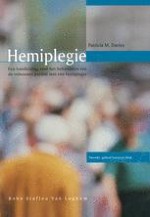Gepubliceerd in:


2001 | OriginalPaper | Hoofdstuk
1. Problemen die niet direct zichtbaar zijn
Abstract
Bij de revalidatie van patiënten die door een cva of een andere unilaterale hersenlaesie zijn getroffen bestaat er een wijdverbreide tendens om de aandacht alleen te richten op problemen die duidelijk zichtbaar zijn. Wanneer de therapeut de patiënt observeert, ziet zij meteen de stand van zijn spastische arm, het onvermogen om zijn vingers te bewegen of zijn hand te gebruiken. Met een oogopslag ziet ze dat hij tijdens het lopen zijn knie in hyperextensie houdt en met zijn voet geen dorsaalflexie kan uitvoeren om van de grond los te komen. De meeste moderne behandelmethoden zijn daarom gericht op het verminderen van de spasticiteit, het stimuleren van activiteit in de paralytische spieren en het de patiënt aanleren hoe hij de dagelijkse handelingen zelfstandig met zijn niet-aangedane hand kan verrichten. Het woord ‘hemiplegie’ legt al in zijn oorspronkelijke betekenis de nadruk op de motorische problemen: een paralyse van de helft (van het lichaam).